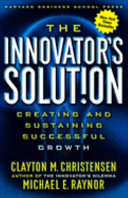

Disruptive innovation is a key concept introduced by Clayton Christensen and is central to the book. It refers to the process by which a smaller company with fewer resources is able to successfully challenge established businesses. The authors explain that disruptive innovations often start at the bottom of the market, targeting overlooked segments, and gradually move up-market, displacing established competitors. This idea emphasizes the importance of understanding customer needs and the potential for new technologies to create entirely new markets. The authors argue that companies must be aware of disruptive trends and be willing to adapt their strategies accordingly. They provide examples from various industries where disruptive innovations have reshaped the competitive landscape, highlighting the need for established companies to embrace change rather than resist it.
Continue readingThe Job-to-be-Done (JTBD) theory is a framework for understanding customer needs and motivations. The authors argue that customers 'hire' products and services to get a job done, and successful innovations arise from a deep understanding of these jobs. The JTBD framework encourages companies to focus on the functional, emotional, and social dimensions of customer jobs, rather than just product features. By identifying the jobs that customers are trying to accomplish, companies can create solutions that better meet their needs. The authors provide case studies and practical advice on how to apply the JTBD theory in product development and marketing, emphasizing that this approach can lead to more successful innovations and a stronger market position.
Continue readingThe book discusses the importance of creating new markets as a strategy for innovation. The authors argue that rather than solely competing in existing markets, companies should look for opportunities to create new markets that address unmet customer needs. This approach involves identifying customer segments that are currently underserved and developing products or services that cater to those needs. The authors provide examples of companies that have successfully created new markets, illustrating how innovative thinking can lead to significant growth. They emphasize that creating new markets requires a willingness to take risks and experiment with new ideas, as well as a deep understanding of customer behavior and preferences.
Continue readingThe authors highlight the importance of business models in driving innovation and value creation. They argue that a successful business model aligns a company's value proposition with its target customers, revenue streams, and cost structure. The book provides insights into how companies can develop and refine their business models to support innovative initiatives. The authors discuss various business model frameworks and strategies, emphasizing that companies must continuously evaluate and adapt their models in response to changing market conditions and customer needs. By focusing on value creation and aligning their business models with innovation efforts, companies can achieve sustainable competitive advantage.
Continue readingLeadership plays a crucial role in fostering a culture of innovation within organizations. The authors argue that leaders must create an environment that encourages experimentation, risk-taking, and collaboration. They discuss the characteristics of effective leaders in innovative organizations, such as their ability to inspire and motivate teams, communicate a clear vision, and support the development of new ideas. The book also emphasizes the importance of aligning organizational structure and processes with innovation goals, as well as providing resources and support for innovation initiatives. The authors provide practical advice for leaders on how to cultivate a culture of innovation and drive successful innovation outcomes.
Continue readingThe authors discuss the importance of establishing metrics to evaluate the success of innovation efforts. They argue that traditional performance metrics may not adequately capture the impact of innovation initiatives, and companies should develop specific metrics that align with their innovation goals. The book provides guidance on how to create and implement innovation metrics that measure progress, assess customer satisfaction, and evaluate the financial impact of innovation. By establishing clear metrics, companies can better track their innovation performance and make informed decisions about future investments in innovation.
Continue readingSustaining innovation refers to the ongoing efforts to improve and enhance existing products and services. The authors emphasize that while disruptive innovation is critical for creating new markets, sustaining innovation is equally important for maintaining competitiveness in established markets. They discuss strategies for sustaining innovation, such as investing in research and development, fostering a culture of continuous improvement, and leveraging customer feedback. The book highlights the need for companies to balance their focus on disruptive and sustaining innovations to achieve long-term success. The authors provide examples of companies that have successfully navigated both types of innovation, illustrating the importance of a holistic approach to innovation management.
Continue reading